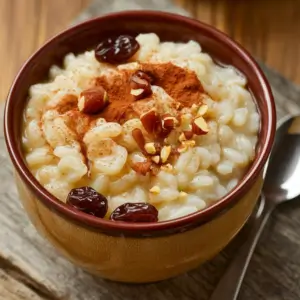Rice Pudding Recipe: A Classic Dessert Made Easy
Rice pudding is one of those comforting desserts that transcends time and geography, with variations existing in different cultures worldwide. It’s a sweet, creamy dish made primarily from rice, milk, and sugar, but there are endless ways to customize it with various flavors and toppings. In this blog post, we will dive deep into how to make a perfect traditional rice pudding, answer common questions about the recipe, and offer useful tips to ensure you create a mouth-watering treat every time.
Table of Contents
ToggleGenerl information
Notes and Tips
Common Mistakes to Avoid
What is traditional rice pudding made of?
Traditional rice pudding is a simple dish made with rice, milk, sugar, and a few basic flavorings such as vanilla and cinnamon. Some variations might include eggs, cream, or additional toppings like raisins or fruit compote.
Nutritional Information
Rice pudding, depending on how it’s prepared, can have varying nutritional values. Here’s a breakdown for a basic serving (about 150g):
- Calories: 150–200 kcal (depending on sugar and cream content)
- Carbohydrates: 30–35g
- Protein: 4–6g
- Fat: 3–5g
- Calcium: Roughly 10-15% of the recommended daily intake, due to the milk content
- Fiber: Minimal (less than 1g)
Opting for brown rice instead of white can slightly boost the fiber content, while using non-dairy milk options like almond milk reduces calorie and fat content.
Additional Ingredients to Experiment With
- Coconut Milk: Swap part of the milk for coconut milk for a tropical twist.
- Orange Zest: A small amount of orange zest can brighten the flavor profile, adding a subtle citrus note that complements the sweetness.
- Chopped Nuts: Almonds, pistachios, or even cashews provide a delightful crunch and nutritional boost.
- Spices: Beyond cinnamon, cardamom and cloves can be used to give the pudding a warm, exotic flavor reminiscent of Middle Eastern or Indian rice pudding.
Alternative Sweeteners
- Honey or maple syrup can be used in place of granulated sugar for a more natural sweetness. These can also add a layer of complexity to the flavor.
- Stevia or monk fruit sweetener offers a low-calorie option for those looking to reduce their sugar intake while keeping the dish sweet.
Rice Pudding Around the World
Rice pudding may have global variations, and some of the notable ones include:
- Arroz con leche (Spain and Latin America): A sweet dish flavored with cinnamon, often using lemon zest and sometimes condensed milk to thicken it.
- Kheer (India): Made with basmati rice, milk, sugar, cardamom, and garnished with nuts and raisins. Sometimes saffron is added for a fragrant and luxurious version.
- Rizogalo (Greece): Greek rice pudding is typically thickened with cornstarch and flavored with cinnamon and vanilla.
- Risalamande (Denmark): A Christmas rice pudding that includes whipped cream, almonds, and often served with a cherry sauce.
Time-Saving Techniques
For those looking to save time or reduce stovetop monitoring:
- Instant Pot or Pressure Cooker: This method reduces the cooking time drastically while still delivering the creamy consistency.
- Slow Cooker: A great hands-off approach where the rice pudding can cook over several hours, perfect for those busy days.
Gluten-Free and Dairy-Free Options
If you’re gluten-intolerant, rice pudding is naturally gluten-free. For those avoiding dairy, you can substitute regular milk with almond, coconut, oat, or soy milk. Just be aware that some non-dairy milk might result in a thinner consistency, so adjust cooking time or add a thickener like cornstarch if necessary.
Origin and History of Rice Pudding
Rice pudding has a fascinating history that spans across continents and cultures. Its origin was in ancient Asia. As it spread to other parts of the world, regions adapted the dish with their own local ingredients and cooking methods. In Europe, rice pudding became popular as a way to use rice brought in through trade.
In England, rice pudding became a popular comfort food in the 14th century, initially served as a savory dish with spices, and later evolving into a sweet dessert.
Choosing the Right Type of Milk
The type of milk you use can drastically affect the taste and texture of your rice pudding:
- Whole Milk: This is the traditional choice and offers the creamiest result due to its higher fat content.
- Skim or Low-Fat Milk: If you’re looking to reduce calories, you can use low-fat or skim milk. The pudding may not be as rich, but it’s a lighter option.
- Plant-Based Milks: Almond, soy, and oat milk work well for vegan or dairy-free versions. Coconut milk, specifically, gives the pudding a tropical richness but also adds a slightly thicker texture due to its higher fat content.
You can also try evaporated milk for a more concentrated flavor, or add a splash of condensed milk for sweetness and creaminess.
Flavor Variations and Customization
Rice pudding is incredibly versatile, and there are several ways to personalize it:
Frequenty Asked Questions
Rice Pudding Texture: Creamy or Thick?
- For a thicker, stiffer pudding, use less milk or allow it to cook longer, so more of the liquid evaporates and gets absorbed by the rice.
- For a creamier, looser consistency, you can add more milk or even stir in a little extra cream towards the end of cooking. Adding the milk or cream slowly at the end ensures that you don’t over-thicken it.
Which type of rice is best?
Short-grain rice like Arborio (commonly used for risotto) is the best choice for rice pudding due to its high starch content. The starch helps to create that signature creamy texture. Long-grain rice can be used, but it tends to be less creamy.
Is rice pudding good for you?
Rice pudding can be healthy, depending on the ingredients used. When prepared with whole milk, it’s a good source of calcium. Choosing to add less sugar and opting for natural sweeteners like honey can improve its nutritional profile. However, as it is a carb-heavy dish, moderation is key if you’re watching your sugar or calorie intake.
Is rice pudding healthy for you?
Rice pudding can be part of a balanced diet if consumed in moderation. It provides essential nutrients such as calcium from the milk, and the rice offers carbohydrates. However, its calorie content can rise if made with cream or high amounts of sugar. You can make healthier versions using low-fat milk and reducing sugar, but it’s still best enjoyed as an occasional treat.
How to make Jamie Oliver’s rice pudding?
Jamie Oliver’s rice pudding recipe is baked, creating a thick, rich texture. He uses ingredients like milk, double cream, sugar, and a pinch of nutmeg to elevate the flavor. You can find variations of his recipe on his official website.
Still Hungry? Check-out these recipes:
- Italian Penicillin Soup
- The best Ninja Creami Ice cream
- The best chicken dumpling soup
- Victoria Sponge Cake
- Rice cakes
- Healthy Breakfast Ideas
- The best Mexican Breakfast
- Chicken salad chick
- Vegan Breakfast

Rice Pudding recipe
Equipment
- A medium-sized saucepan
- A whisk or wooden spoon
- Measuring Cups and Spoons
Ingredients
- 1 cup short-grain rice
- 4 cups milk
- 1/2 cup granulated sugar
- 1 teaspoon vanilla extract
- 1 cinnamon stick
- Pinch of salt
Instructions
- Rinse the Rice: Rinse it under cold water. This helps prevent clumping.
- Heat the Milk: In a medium saucepan, bring the milk to a gentle simmer over medium heat. Add the cinnamon stick or ground cinnamon for an extra touch of flavor.
- Cook the Rice: Stir in the rice and a pinch of salt. Reduce the heat to low, and let the rice simmer, uncovered, for about 20-30 minutes, stirring frequently to avoid sticking.
- Add Sugar and Vanilla: Once the rice has softened and the mixture thickens, add the sugar and vanilla extract. Stir continuously until the sugar is dissolved, and the pudding reaches a creamy consistency.
- Final Touches: Remove the saucepan from heat, and discard the cinnamon stick (if used). Let the pudding cool slightly before serving. Garnish with raisins, ground cinnamon, or a sprinkle of nutmeg if desired.







